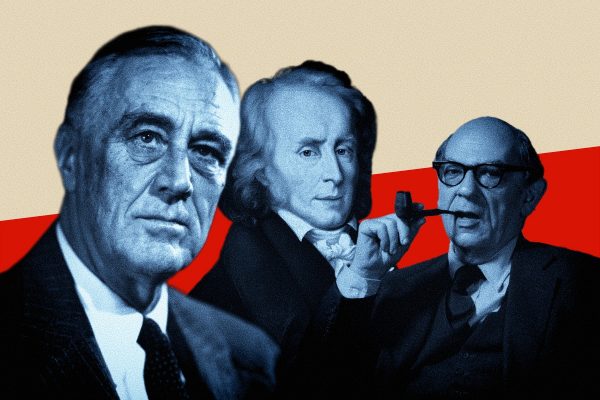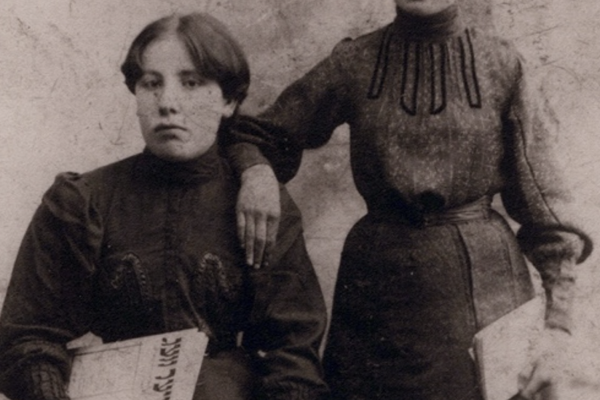“Dear Sir, I don’t like the way you crossed me out.”
That was the entirety of a letter written by Virginia Mann, the six-year-old daughter of photographer Sally Mann, to the writer Raymond Sokolov and the Wall Street Journal in 1991.
To illustrate Sokolov’s critique of Mann’s work, the Journal had purloined the picture “Virginia at Four,” which had been published on the cover of Aperture magazine, cropped out the image of another girl in a white dress, lightened Mann’s signature loamy black ground to pulp gray, and covered the child’s eyes, naked nipples, and pubis with censor bars.
“The nation’s largest-circulation newspaper cropped and disfigured my photograph as if it were Exhibit A in a child-pornography prosecution,” Mann writes this month in the New York Times Magazine.
In the piece, “Sally Mann’s Exposure,” the photographer describes her work as piercing the “cult of childhood innocence.” Her pictures portray children as what they are—“wise, angry, jaded, skeptical, mean, manipulative, brooding, and devilishly deceitful”—and childhood as scary and painful as well as joyful, easeful, and magical.
Yet she also insists that children—or her pictures of them; it is not totally clear—are not sexual. In 1992 she said, “I think childhood sexuality is an oxymoron.” This time she qualifies. Of course, “all living creatures are sexual on some level”—including her kids. But “to confuse it with what we call sexuality, inter-adult sexual relations, is a category error.”
Similarly, the passion adults feel toward children is pristine, or—if they are sane and good—should be. “I don’t think of my children, and I don’t think anyone else should think of them, with any sexual thoughts,” she said in 1992. Now she writes of the “primal parental eroticism” her children stirred in her. But she reiterates: seeing and photographing them, the children’s bodies were “simply, miraculously and sensuously beautiful.”
It is delicate labor, this parsing of categories—erotic versus sexual, beautiful versus desirable, child versus adult. And it is quixotic. Indeed, the power of Mann’s photographs emanates from the places where the categories overlap and the dissonances vibrate—the perfect flesh slimed with mud, scraped and sliced by brambles and tumbles; the river-bottom dark illuminated by moats of celestial light.
It is delicate labor, this parsing of categories—erotic versus sexual, beautiful versus desirable, child versus adult. And it is quixotic.
The art historian Anne Higonnet sees Mann as a victim of history. Questions about her work—is it objectifying, exploitative, pornographic?—inevitably arise now, in “the final agonies of Romantic child innocence,” Higonnet wrote in Pictures of Innocence (1998). “As long as the ideal of Romantic childhood lingers”—the ideal of a nonsexual, unworldly being, utterly distinct from adults—“as long as it seems viable, work like Mann’s will violate that ideal.”
But now, as in 1992, Mann clings to that ideal. She has yet to be arrested by the vice squad, but she can’t stop explaining herself to the officer, confessing and defending herself by turns.
I’ve heard this before from “sex offenders”: the guilty self-justification of a person who knowingly committed a crime such as consensual sex with someone a few years their junior, which should not be considered criminal. It is tragic to witness: the sexually paranoid culture shaking a mea culpa from a lover or a harmless deviant, codifying and adjudicating the ambiguities of Eros. Flattening art into pornography.
In fact, “Virginia at Four,” or any of the hundreds of other pictures Mann made of her three children, could have become Exhibit A in a child-pornography prosecution.
In the mid-1970s, after a decade of relative sunniness about child sexuality and family nudity—the Manns in their rural hippie idyll prolonged that decade—the sky darkened with anxiety about child sexual exploitation. There had been no surge in child pornography production or distribution. But the government began broadening the definition of offending images and intensifying its search for their makers, traders, and viewers.
In 1977 Congress passed the Protection of Children Against Sexual Exploitation Act, prohibiting the production and commercial distribution of obscene depictions of children younger than sixteen—upping the legal age from twelve. In 1984 the Child Pornography Protection Act raised it again, from sixteen to eighteen.
Over the next decade, the law widened its purview from production and distribution of child-erotic images to possession, and then to viewing as well. The 1993 Supreme Court case U.S. v Knox expanded the definition of child porn to images in which the minor is neither naked nor doing anything sexual—if they might appeal to the “lascivious interests of a pedophile.”
The 1996 Child Pornography Protection Act deemed pornographic the erotic depiction of any person intended to look like a minor, including computer-generated images. Prosecutorial zealotry has no bounds. Today teen sexters can be imprisoned for up to thirty years on child pornography charges—perhaps the first crime of which a person can be both perpetrator and victim.
No one knows how much child pornography there is. Journalists and scholars are typically prohibited from viewing it. But it is safe to say that its prevalence does not match the law’s vigilance. From 1996 to 2010 the number of convictions for possessing sexually explicit material (mostly child pornography) increased sixty-fold.
Into this manhunt ventured Immediate Family, Mann’s 1992 collection of ten years of photographs of her children, about a quarter of them nude. The volume met deserved acclaim, as well as condemnation. This time, though, the critics were not just conservative busybodies such as Ray Sokolov; no less than the New York Times Magazine submitted an amicus brief for the prosecution.
The article was called “The Disturbing Photography of Sally Mann.” And in the agnostic voice of the Gray Lady, art critic Richard B. Woodward nudged any reader who was not yet disturbed to become so. “If it is [Mann’s] solemn responsibility, as she says, ‘to protect my children from all harm,’ has she knowingly put them at risk by releasing these pictures into a world where pedophilia exists?” Woodward asked. “Can young children freely give their consent for controversial portraits, even if—especially if—the artist is their parent?”
He continued: “Do these sensual images emerge from the behavior of her subjects or are they shaped by the taste and fantasies of the photographer for an affluent audience? Is it pandering or bravery, her willingness to photograph what other adults have seen but turned away from?”
Consent. Taste and fantasies. Pandering. The words insinuate coercion, perversion, and obscenity.
Although Mann has been “spared . . . litigation,” Woodward wrote, the nudity has “caused problems” for publications and “raised worrying personal concerns.” The nudity engendered problems for editors; it was not the editors who had problems with nudity. The personal concerns were “worrying”; it wasn’t that concerned citizens, including the writer, were worried for their own reasons. The photographs were “controversial.” And it went without saying that controversy—this sort of controversy—was harmful to children.
Worst of all, this mother was sending images of her children’s vulnerable bodies into a world where pedophilia exists. The implication was not just that sexual danger had intensified and was worse than any other—racist violence, war, climate change—but also that privacy is sanctuary.
Child pornography law was meant to rescue children from marketable sexual objectification and return them to that mythic realm of safe, nonsexual, innocent childhood. But the New York University legal scholar Amy Adler argues that it does exactly the opposite.
“Child pornography law has changed the way we look at children,” Adler wrote in an influential 2001 Columbia Law Review article, “The Perverse Law of Child Pornography.” “I mean this literally,” she added. Such laws, she argued, have “opened up a whole arena for the elaborate exploration of children as sexual creatures. Cases require courts to engage in long, detailed analyses of the ‘sexual coyness’ or playfulness of children, and of their potential to arouse. Courts have undertaken Talmudic discussions of the meanings of ‘pubic area’ and ‘discernibility’ of a child’s genitals in a picture at issue.”
“Even when a child is pictured as a sexual victim rather than a sexual siren”—or, I’d add, as a person with no proximate relation to sex at all—“the child is still pictured as sexual.”
Now read Woodward: “The extraordinary care taken in rendering the flesh, including the attention paid to incipient sexual characteristics, is not accidental,” he wrote. “By the cropping and ‘burning in’ of detail, Mann presents obsessive — not casual or clinical — examinations of her young children’s nakedness.”
Child pornography law was meant to rescue children and return them to that mythic realm of safe, nonsexual innocent childhood. It did the opposite.
Who was engaging in the obsessive examination of the children’s nakedness? In describing “Virginia at Four,” Woodward called the little girl’s flat chest “breasts,” her hairless mons “genitals.” Who was zooming in on sexual characteristics—which, in that picture, were not even incipient?
“In order to root out pictures of children that harbor secret pedophilic appeal,” Alder wrote, the law “explicitly exhorts us to take on the perspective of the pedophile.” Rather than shield the child from adult desires, this makes “children all the more sexually alluring.”
Mann reveals in her recent piece that at least one viewer of Immediate Family found her children sexually alluring and took action. For years, he obsessively, and terrifyingly, stalked the family. The confession and the defense: the photographer seemed to blame herself for naiveté. “Perhaps some measure of foolishness,” let her imagine she could shield her family from misinterpreting or predatory eyes.
“I made pictures I thought I could control,” she writes, “pictures created within the prelapsarian protection of the [Manns’] farm, those cliffs, the impassable road, the embracing river.” But her foolishness was the perception of control, not of her family’s Eden.
The farm was not just protective; it was “prelapsarian.” There, if the children were sexual beings, theirs was the sexuality of Adam and Eve and the beasts in the Garden, their seductive poses and expressions the innocent play of a Rousseauvian wild child.
The notion that the family home is a fastness and the outside world—the urban street, the Internet, the published book—a zone of moral peril is a Victorian one, a nineteenth-century extension of the eighteenth-century Romantic ideal of the unspoiled child in Nature. The federal agents trawling the Internet for pornographers are mobilized by the same fiction that the abuser is a stranger; most abused children are victimized at home.
Along with this imaginary geographical distinction, Mann constructs a relational one: between parenting and art-making, herself as “old-fashioned” doting mother on one hand, and on the other the confectioner of fictions, with young collaborators.
“When I stepped behind the camera and my kids stepped in front of it, I was a photographer and they were actors, and we were making a photograph together,” she writes. “These are not my children at all; these are children in a photograph,” dressed in costumes, assuming roles—a distinction she says the actors understood.
Maybe this is the necessary self-delusion of the artist or memoirist who uses people she loves as subjects: that her intent is honorable and that this intent inoculates the subjects against the harm the public—or the work, which is to say, the author—might inflict. Anyway, if life is real and art is illusion, then art cannot wound.
Unfortunately, the contention that the people in the pictures are actors, not her son and daughters, will only add evidence to the charge that Mann objectified her children—in the language of child pornography prosecutors, that she “groomed” them for exploitation. Mann is in history’s crosshairs, Higonnet contended, and “nothing [she] can intend or do or say will prevent” viewers from interpreting her pictures as they are wont—or culturally compelled—to interpret them. “Anyone who already sees children incestuously or viciously will certainly see incest or vice in Mann’s erotics.”
But that is one interpretation. Art—and, for that matter, pornography—affords permission to fantasize but not to share the fantasy or impose it on others; to feel, to desire, and not to act.
Protest as Mann may, her work belies the distinctions she insists on—between Eros and sex, emotional worldliness and sexual innocence, safety and danger, fiction and reality. In the photographs the children are both knowing and naive, their bodies whole and violated. They are innocent and erotic—and sexually alluring—all at once.








